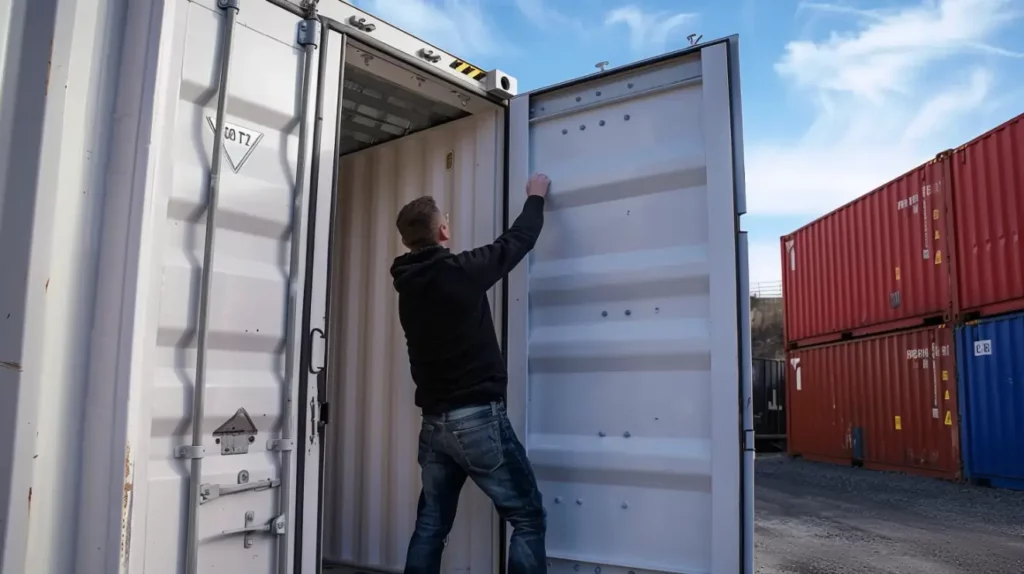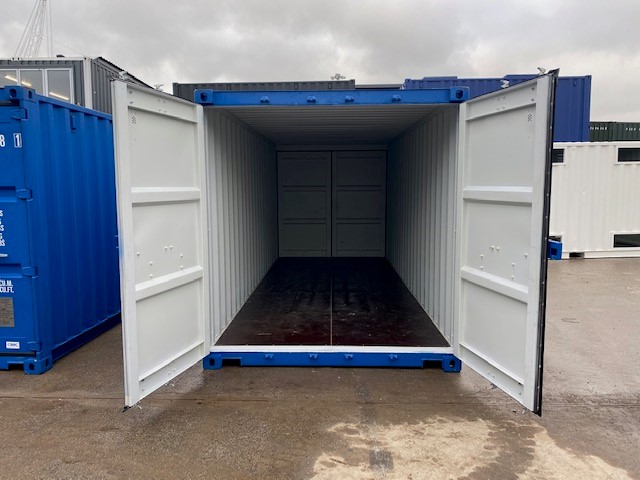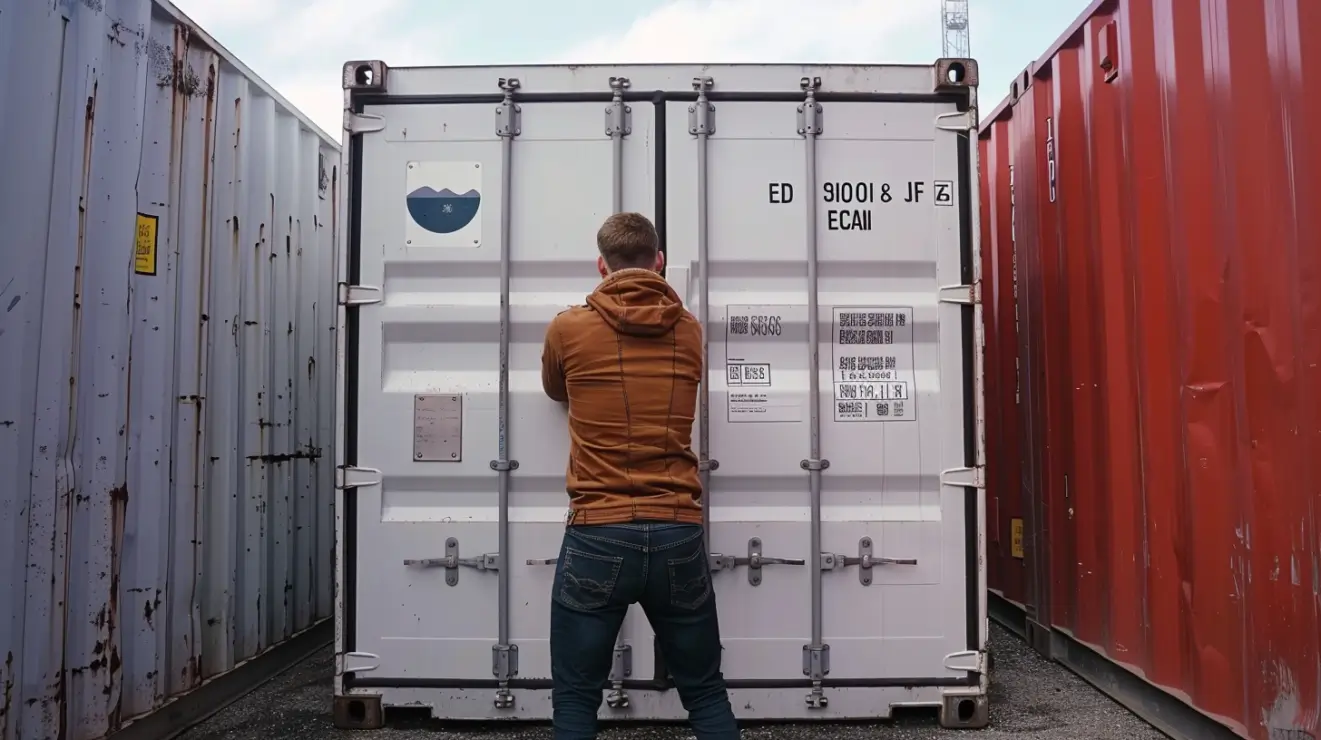Shipping containers have gone from a specialist shipping tool to an everyday sight. Today, they’re used for garden storage, portable offices, and holiday lets – as well as moving most of the world’s goods.
It’s important to know how to open and close your container safely. Handling the doors properly protects the cargo inside, increases the container’s security and durability, and protects you from accidents and injuries.
Understanding the parts of shipping container doors
Before you get hands-on with your container doors, you need to know all the parts that make them work. Shipping container doors aren’t like the regular doors that you’d find in a house. They’re heavier and use much more complex locking mechanisms.
Door bodies
Most shipping containers have double doors made from corrugated steel panels. There are hinges on all four corners of the doors, which open from the middle outwards. Some containers may have a side door opening instead of the usual double doors.
Slide bolt
Once the shipping container doors are closed, they’re secured with a slide bolt. This is also sometimes called a shipping container bolt or a cane bolt. It’s a metal rod or bar which slides horizontally across the doors into a socket on the container’s frame.
Locking rods and handle
Similar to slide bolts, locking rods are steel rods that help secure the container doors. They run vertically from top to bottom of the container doors. Most containers have 2-4 locking rods, also known as locking bars or container door bars.
Handles
Each locking rod has a door handle on it. They’re there to make it easier to open, close, and lock the container doors.
Cane bolt and spring latch
Most containers have a cane bolt and spring latch fitted to the bottom right corner of the doors, inside the container. They prevent the doors from swinging open too widely—as well as providing another secure lock.
Rubber gaskets
Rubber gaskets are seals around the edges of shipping container doors and openings. They prevent water, dust, and pests from getting in.
Hinge pins
Shipping container hinge pins connect the container doors to the frame and allow them to swing open and closed.
Lockbox
A lockbox is the last built-in security feature of shipping containers. It’s a steel box which is welded to the doors. You can lock the doors with a padlock, then lock the lockbox over the top. If someone tries to break into the container, they’ll have to get through an extra layer of security before they can attack the main padlock.
Looking for reliable shipping container door parts?
Find a wide range of locks, hinges, seals, and more to keep your doors working smoothly!
Buy container door partsAre shipping containers hard to open and close?
Shipping container doors are strong and heavy. However, they’re designed to swing open and shut with relative ease. If the doors are properly aligned and maintained, they should be easy to open.
The doors on new or one-trip containers are usually easiest to open, because they’re in excellent condition. Older containers might need a little oil to loosen them up. The one thing you should never do is use a crowbar or lever to bust the doors open, because it can cause more damage.
Preparing to open a shipping container
It might sound strange, but it’s much easier to open a container when you’ve prepared the ground for your shipping container. If the ground is uneven or sloping, the doors could get jammed.
You’ll want to place the container on a flat, cleared space before you try to open it. Make sure that the area around the doors is free from debris so that they can swing open. Last of all, check the exterior of the container for any signs of damage.
How to open a shipping container door
Because shipping containers are large and heavy, it’s important to know how to unlock them safely. Follow the steps below to safely open your container and make sure to take your time.
Unlock the locks
Start by unlocking the lockbox and removing any padlocks from inside. Check for any other padlocks on the locking bar handles and remove them.
Open the right-hand side door

Pull the handle of the slide-bolt (the horizontal bar) to the right, then flip the tabs of the handles on the locking bar (the vertical bar) up. Some container doors might have more than one locking bar, so you’ll need to do this for any vertical bars on the right-hand door.
Next, stand directly in front of the door. Grab the handles on the vertical locking bars and pull them toward you so that they stick out about 90 degrees from the door. When you pull them simultaneously, they should release from the cam locks at the bottom and top of the door.
The door will start to swing open. You can then use the bar inside the door to guide it open all the way.
Open the left-hand side door

Before you can open the left-hand door like the right-hand door, you need to release the cane bolt and spring latch. Look inside the container at the bottom right corner of the door. Lift and turn the cane bolt to the right to open it.
After releasing the can bolt, you’ll be able to open the left-hand door. Pull the locking bar handles towards you simultaneously, just like you did for the right-sided door.
How to close a shipping container
To close your shipping container, you’ll essentially follow the same steps in reverse. But it’s important to get every detail right so that your container is firmly closed and fully secured.
Close the left-hand side door
First, check that the cane bolt inside the container doors is still in the open position. Grab the locking bar handles on the left-hand door and pull them toward you. Without letting go of the handles, push the door closed. You can adjust the locking bar handles as you go to align them with the cam latches. The door won’t shut until you have found the right alignment.
Once everything is in position, push the locking bar handles to the left so that they rest against the container door. Flip the handle tabs down so that they’re locked in place. Finally, turn the cane bolt inside the container to the left until it drops down into the locked position.
Close the right-hand side door
Once the left-hand door is closed, you can shut the right-hand door. Start by pulling the locking bar handles up and towards you, away from the door. Push the door closed, aligning the handles as you go so that the locking bars latch into place.
Once the door is closed and the locking bars are aligned, push the handles to the right so that they rest against the container. Flip the handle tabs down to secure them in place. Last of all, push the horizontal slide bolt back across the doors.
Secure your container
Use a puck lock to lock the slide bolt tab. Put a padlock in the lockbox and lock it to secure the shipping container. You can also add padlocks to the locking bar tabs for even more peace of mind.
Need a replacement shipping container door?
Explore our durable and secure options today!
Buy Shipping Container doorsWhy container doors get stuck and how to fix them
Without the right maintenance, shipping container doors can get stuck. Stiff or trapped doors can even cause damage to the container over time if the problem isn’t resolved. Here are some of the most common problems and how to fix them.
Maintenance neglect
Shipping containers need regular maintenance to spot and fix weaknesses in the structure. For example, locking components can get stuck if they aren’t checked and lubricated regularly. It’s a good idea to oil the hinges, locking bars, and seals with grease or a high-quality rust inhibitor on a regular basis.
Rust and corrosion
Shipping containers are made from corten steel which is resistant to rust and corrosion. However, it can still corrode over time. Check the hinges and locks regularly for signs of rust. You can apply a penetrating oil or rust remover to components which have started to stick. To prevent shipping container rust in the long term, use an anti-corrosion spray or grease.
Physical impact
Shipping containers endure a lot of punishment in transit. They’re moved by cranes, stacked on top of each other, and buffeted by ocean waves. That can cause dents, twists, or misalignments over time.
Check your container regularly for dents or signs of misalignment. You can use a pry bar or rubber mallet to gently realign bars and locks. If the frame of the container itself is warped, you can use a jack or shim to bring it into a level position.
Uneven container placement
Shipping container doors are easiest to open when they’re placed on level ground. Over time, an uneven surface can warp the doors or locking rods.
If the doors are sticking, check that they are aligned and level with the top and bottom of the container. If one door is lower than the other, use a car jack to lift it slightly and put a steel or timber support underneath.
Unsure how to properly level your shipping container?
Get step-by-step advice on how to level your container properly, preventing structural issues, water damage, and shifting while making sure it stays stable and functional for years to come.
Get expert advice to keep your shipping container stable, secure, and free from structural issues in our in-depth guide.
Learn moreTemperature influences
Strange as it sounds, changes in the weather can make a big difference to shipping container doors. For example, temperature changes can make the steel frame expand and contract, damaging the locking bars and hinges. If there’s moisture on the doors and temperatures plummet below zero, then ice can crack or warp the steel.
To avoid these issues, give your container time to acclimate to the surrounding temperature before you try to open the doors. If you notice ice trapped between the doors, pour warm (not boiling) water along the rubber door seals to release it. You’ll also need to monitor the container for signs of internal moisture build-up in cold weather.
Inadequate tools
When they’re working smoothly, you can open container doors without any special equipment. But in some cases, you might need tools—such as bolt cutters, pry bars, or specialised locking mechanism tools.
Make sure that you have the recommended equipment for your container and locking mechanisms. Using the wrong tools could damage the container or make it harder to open.
Challenges with container seals
Depending on the cargo, some shipping containers use adhesive materials or seals for extra environmental protection. However, these can become hard, worn, or sticky over time. If your container has seals, you’ll need to check and replace them regularly to avoid problems.
You can open hardened seals by cutting away the adhesive material with a seal-breaking tool or utility knife. In extreme cases, you could also apply a penetrating oil or sealant remover to soften the seal before you cut it.
Damage to the door gasket
Like rubber seals, door gaskets are designed to fill in tiny gaps around the door and keep the container waterproof. However, they can break down over time – and make it almost impossible to close container doors properly.
If you think there’s a broken gasket in the container, start by inspecting it for cracks or wear. Make sure that the gasket is still flexible and can move easily. Clean the area and apply a lubricant so that it can keep moving.
Broken hinges can also prevent container doors from closing. You can try to fix them with lubricant or anti-corrosion spray, or replace the hinge altogether.
Security enhancements
Some shipping containers have extra security features to lower the risk of theft. For example, a high-security container might have extra heavy-duty locking bars, an electronic locking system, reinforced doors and frame, tamper-evident seals, an alarm system, GPS tracking, or even barbed wire.
These security features are effective, but they also make it harder to open the container for legitimate purchases. You’ll need to keep track of all the keys, unlocking tools, and passwords related to your container.
It’s also important to inspect and maintain all the security features regularly. If they start to malfunction, it’s likely that you’ll need help from a professional locksmith.
Racking
“Racking” is an industry term for when a container twists slightly in place. This makes the doorframe shift so that it’s no longer square. The doors and the doorframe are out of alignment, which can cause them to get stuck.
You can try to fix racking by using a jack to lift the container and adjust the door frame back into place. Once it’s correctly aligned, try to gently close the doors. However, in some cases, you will have to replace the door hinges to resolve the issue.
Top tips for opening and closing shipping container doors
You’ll soon get used to the opening and closing mechanism on your shipping container doors. Follow these quick tips to make sure you’re staying safe and keeping the container in good condition.
- Always open the doors one by one. Don’t try to swing both open at once.
- Bend your knees as you pull the doors open. Because they’re heavy, you don’t want to put undue strain on your back, neck, or shoulders.
- Make sure that the container is on a clear, level surface.
- Watch out for any pressure or sounds of moving objects as you open the doors. Cargo could fall towards you when you open the doors.
- Whenever possible, have someone else with you when you open the container doors. They can help stabilize the doors and protect against accidents.
- Wear personal protective equipment, such as a hard hat and steel-toed boots, when you’re working with cargo loads. Gloves will give you better grip on the doors, while the boots and helmet will protect you from falling cargo.
The bottom line
Container doors are designed to be strong, secure, and watertight. That means their locking mechanisms can be complicated. However, once you understand the container’s design and a few basic safety tips, you should be able to open and close the doors with ease.





